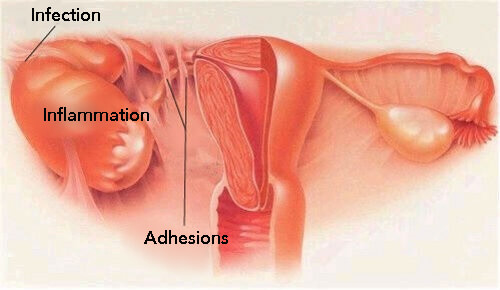Symptoms of Pelvic Inflammatory Disease (PID)


Written and verified by psychologist Valeria Sabater
You might be familiar with the term, but do you know the symptoms of pelvic inflammatory disease? This condition is pretty common, and stems from an infection in the uterus, the Fallopian tubes, or the ovaries. It causes quite a bit of pain, especially intense pain in the pelvis or hips.
What causes the infection that leads to this disease? Bacteria, otherwise known as foreign elements that infect your reproductive organs and cause this fairly common disease.
If not treated promptly, pelvic inflammatory disease can lead to serious problems like infertility. It’s worth taking the time to learn about the symptoms and be able to prevent it, ensuring your good health. We’ve laid it all out for you in the article below.
1. What is pelvic inflammatory disease?

Pelvic inflammatory disease is a gynecological problem that affects both your reproductive organs and the surrounding tissues. You may suffer from an infection in the Fallopian tubes, womb, or ovaries, which can cause you to experience pain all the way up to your hips. Many women experience this pain and confuse it with joint pain or general fatigue. So, you’ve got to be careful about this!
You might like: 7 Ways to Trim Down Thick Hips for Good
You usually treat it with antibiotics, and if you don’t act fast enough, it can cause serious problems like the ones we mentioned above: infertility, or even pregnancies that end in miscarriages.
The causes of pelvic inflammatory disease
Pelvic inflammatory disease has a number of causes, including:
- Sexual transmission: the bacteria from sexually transmitted diseases, such as chlamydia, are some of the most common causes of this disease.
- Some types of birth control devices can be a potential cause of PID too. For example, women who use intrauterine devices (IUD) are more likely to get pelvic inflammatory disease than women who don’t.
- Also, be careful with so-called “vaginal douches.” This intimate part of your body needs to be treated delicately, and these types of cleansing products can sometimes do more harm than good.
- It’s also important to follow a proper hygiene routine while menstruating, because this time of the month can often be a huge source of bacteria.
- The process of giving birth, or even having an abortion, can also cause you to get this disease.
- Surgical operations in the uterus performed through the vagina are also a risk you should keep in mind.
- The mucous membranes of the cervix can occasionally become overly alkaline, causing a series of bacteria to appear and possibly make you sick.
- The presence of benign tumors such as fibroids or polyps is also a possible cause.
Symptoms of pelvic inflammatory disease

One extremely important thing to keep in mind: sometimes, this disease can occur without any symptoms. That’s why it’s important to always do routine gynecological check-ups because, as you know, PID can cause very serious problems. However, pelvic inflammatory disease usually provides clear clues in the form of annoying bodily changes. Here’s a list of some of the symptoms of pelvic inflammatory disease
- Very strong hip pain on both sides. It’s a sharp pain that can make you to feel tired or like you need to take an painkiller or muscle relaxer.
- Another one of the symptoms of pelvic inflammatory disease is that you might feel pain in your stomach. It’s a very particular, heavy burning sensation.
- This disease is caused by infection, so it’s quite common for people with it to contract a slight fever. Even just two degrees above normal is enough that you should go to the doctor.
- You should also pay attention to your vaginal secretions, especially if they have a very strong and unpleasant odor. This isn’t normal.
- Also pay attention to your menstrual cycle. Are your periods irregular? Do they sometimes come late? Do you experience spotting between periods? If so, you should make an appointment with your doctor.
- You should also go see your gynecologist if you experience pain while having sex. It’s a clear sign that you need to keep in the back of your mind.
- Is urinating painful for you? Do you feel like you really have to pee and then, when you go to the bathroom, you only go “a few drops”? If so, make an appointment with your doctor.
- Feeling nauseous for no reason, feeling bloated, or vomiting after a meal are all fairly serious symptoms of pelvic inflammatory disease that you should keep in mind.
Read more: Pain When Urinating: Causes and Symptoms
How can I prevent pelvic inflammatory disease?

Be careful when having sex and when it comes to choosing which type of birth control you’re going to use.
- Take care with your intimate hygiene. Sometimes, we go overboard in terms of the products we use for intimate hygiene, which alters the natural balance of vaginal bacterial flora.
- Be alert for any changes in your menstrual cycle or vaginal flow. If you’re having any irregularity or problems, go see your doctor immediately.
- Sage tea. This medicinal plant has a long history of protecting women’s health. Sage regulates menstruation, alleviates pain, helps you keep from getting bloated, reduces swelling, and prevents water retention. It’s definitely worth drinking a cup every day.
- Periodic check-ups with your gynecologist are key to keeping this type of disease from progressing. If detected in time, you’ll avoid any more serious complications, so don’t put off these appointments or be too afraid to go. Your health and your well-being depend on it.
All cited sources were thoroughly reviewed by our team to ensure their quality, reliability, currency, and validity. The bibliography of this article was considered reliable and of academic or scientific accuracy.
- World Health Organization. Sexually Transmitted Infections. 2016.
http://www.who.int/en/news-room/fact-sheets/detail/sexually-transmitted-infections-(stis) - MedlinePlus. Enfermedad inflamatoria pélvica. https://medlineplus.gov/spanish/pelvicinflammatorydisease.html
- Pelvic inflammatory disease. Valcencia Higuera reviewed by Debra Rose Wilson, PhD, MSN, RN, IBCLC, AHN-BC, CHT. (2017).
womenshealth.gov/a-z-topics/pelvic-inflammatory-disease - Office of Women’s Health. Enfermedad inflamatoria pélvica. https://espanol.womenshealth.gov/a-z-topics/pelvic-inflammatory-disease
- Centros para el Control y Prevención de Enfermedades. Enfermedad inflamatoria pélvica: Hoja informativa de los CDC. https://www.cdc.gov/std/spanish/eip/stdfact-pid-s.htm
This text is provided for informational purposes only and does not replace consultation with a professional. If in doubt, consult your specialist.








